印度—欧亚板块碰撞带作为一个典型的陆-陆碰撞造山带,持续至今的碰撞和汇聚产生了青藏高原,也使青藏高原成为地震活动最频繁、构造活动最剧烈的地区之一.有关青藏高原的深部构造特征和地球动力学问题是地球科学研究的热点,特别是处于碰撞前沿的喜马拉雅造山带备受地球科学家的关注(Tapponnier et al., 1982; Yin and Harrison, 2000; 许志琴等, 2008; 滕吉文等, 2019).喜马拉雅东构造结地处喜马拉雅造山带东端,位于板块碰撞核心,区域内水系、山脉和断层有一个近90°的大转弯,地形起伏可达5000 m,岩石圈变形十分剧烈(Tapponnier et al., 2001).东构造结由北至南可划分为拉萨地体、雅鲁藏布江缝合带和喜马拉雅地体三个构造单元,是喜马拉雅山脉构造应力最强、隆升和剥蚀最快、新生代变质和深熔作用最强的地区之一(许志琴等, 2008; 彭淼等, 2012).P波接收函数计算得到的东构造结地壳厚度变化趋势表明,南迦巴瓦地区地壳厚度约为50 km,喜马拉雅地体北部和雅鲁藏布江缝合带地壳厚度约为60 km,在东西方向略有变化,拉萨地体的地壳厚度由嘉黎断裂附近的64 km迅速增加到怒江断裂的72 km(Wang et al., 2019).同时,东构造结构造变形剧烈,强震频发,1900年以来共发生5.5级以上地震81次,其中包括1950年8.6级察隅地震和2017年6.9级林芝米林地震(李国辉等, 2020).综上所述,喜马拉雅东构造结地形变化剧烈,地质构造复杂,地震活动频繁,是研究陆-陆碰撞过程中岩石圈变形模式和构造演化规律的天然实验场,研究其地球内部结构和岩石圈变形特征对探索青藏高原陆-陆碰撞造山带的动力演化过程具有重要意义.
地球内部介质普遍具有各向异性特征(Anderson, 1961),地震各向异性是研究地球内部介质变形的最有效方法之一(Savage, 1999),对揭示地球动力学机制有重要意义(Silver, 1996).一般认为上地壳各向异性主要由上地壳中裂隙的定向排列引起,受到水平主压应力控制(Crampin and Atkinson, 1985; Crampin, 1994; Crampin and Peacock, 2008),而中下地壳由于围压增加使裂隙闭合,其各向异性来源于岩石中矿物和熔体的定向排列(Barruol and Mainprice, 1993; Weiss et al., 1999).上地幔各向异性一般被认为是由橄榄石等造岩矿物在应力作用下晶格的优势排列导致的(Nicolas et al., 1973; Christensen, 1984).横波分裂方法是研究地球内部介质地震各向异性的常用方法(Crampin, 1981),快波偏振方向和慢波延迟时间分别反映了壳幔介质变形的方向和强度(Crampin, 1984; Silver, 1996).国内对青藏高原的横波分裂研究始于20世纪90年代,丁志峰和曾融生(1996)、吕庆田等(1996)、姜枚等(1996)和史大年等(1996)利用中外合作架设的流动台站的地震观测数据,在青藏高原中部开展了SKS波分裂研究,分析了该地区的上地幔各向异性特征.青藏高原的横波分裂各向异性研究已开展近30年,获取了大量的横波分裂测量结果(Sol et al., 2007; 王椿镛等, 2007; 常利军等, 2008, 2010; 丁志峰等, 2008; Chen et al., 2013; Chang et al., 2015, 2017, 2018; 谢振新等, 2017; 高原等, 2018; Gao et al., 2019; 郭铁龙和高原, 2020; 吴鹏等, 2020; Zheng et al., 2021; 王凯悦等, 2021),为认识青藏高原壳幔各向异性特征和动力学机制提供了重要依据.
在喜马拉雅东构造结已有的SKS波分裂研究(Sol et al., 2007; Chang et al., 2015)中,东构造结及周边地区的上地幔各向异性快波偏振方向自西向东呈绕东构造结顺时针旋转的趋势,其中Chang等(2015)联合SKS波分裂、GPS速度场等综合分析了岩石圈变形特征,结果表明喜马拉雅东构造结岩石圈变形为壳幔耦合的垂直连贯变形模式.王凯悦等(2021)在东构造结利用可视化测量方法进行了近震直达S波分裂测量,获取了东构造结上地壳各向异性特征,但由于近震S波的传播路径局限在上地壳,无法得到中下地壳的各向异性特征.Pms波是近垂直入射P波在莫霍面的转换波,其传播路径为莫霍面至台站,应用Pms波分裂得到的各向异性参数可以反映整个地壳的各向异性特征.在喜马拉雅东构造结已有的上地幔和上地壳横波分裂研究基础上,进一步开展Pms波分裂研究,可以获得地壳整体的各向异性特征,并与已有的上地幔和上地壳各向异性结果进行对比分析,提高横波分裂测量纵向分辨的约束,进而分析讨论岩石圈壳幔各向异性的分布和动力学含义.
本次研究中我们使用喜马拉雅东构造结及周边地区48个流动地震台站的数据资料,在提取接收函数得到Pms波后,进行横波分裂测量以获取地壳各向异性参数,进而获取喜马拉雅东构造结的地壳各向异性特征,并结合已有的横波分裂测量等研究进行对比分析,探索东构造结壳幔各向异性分布和岩石圈变形机制.
1 数据与方法远震数据由三部分组成,第一部分为中国地震局地球物理研究所2015—2017年在雅鲁藏布江下游地区架设的16个宽频带流动地震台站的波形资料,这些流动地震台站统一应用了REFTEK数据采集器和CMG-3ESP地震计(频带范围为50 Hz~60 s),由GPS系统定位和授时;为了增加台站的覆盖范围和密度,我们还收集了中国地震局地球物理研究所2007—2008年在喜马拉雅东构造结架设的10个宽频带流动地震台站的波形资料(Wang et al., 2019),以及Lehigh University和成都地质矿产研究所2003年至2004年在研究区架设的25个宽频带流动地震台站的波形资料(Sol et al., 2007);其中中国地震局地球物理研究所先后两次架设的台站中有3个台站(BEB、DAM和TOM)位置重合,本次研究合计使用了48个流动地震台站(图 1)的波形资料.参照地震目录对地震事件进行挑选,选取震级在5.0级以上、震中距在30°~90°、三分量完整的地震事件波形.对地震台站三分量记录进行去均值处理,之后进行带通滤波(0.03~0.3 Hz),去除仪器响应,最后旋转水平分量得到径向和切向分量.为增加接收函数可靠性,筛选信噪比较高的波形记录应用时间域反褶积方法(Ligorría and Ammon, 1999)提取接收函数.通过接收函数随后方位角变化规律(图 2)可以观察到Pms波的径向分量部分到时提前,且切向分量存在90°反对称变化,表明接收函数符合水平各向异性介质特征.在提取接收函数之后,挑选Pms波形清晰的接收函数用于Pms波分裂测量,共选取了241个地震事件(图 3).
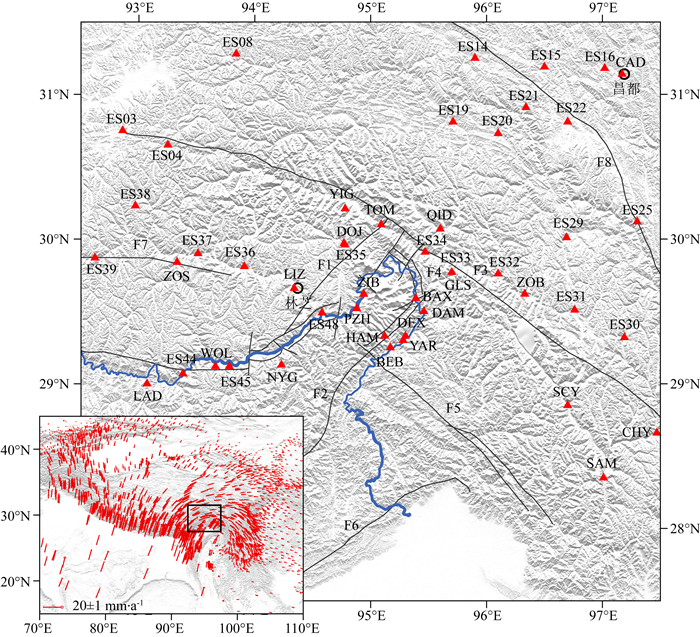
|
图 1 喜马拉雅东构造结地质简图 图中红色三角表示地震台站,黑色圆形表示城市,黑色线段表示研究区域内缝合带和大型活动断层:F1:雅鲁藏布江断裂; F2:墨脱断裂; F3:嘉黎断裂; F4:迫龙—旁辛断裂; F5:阿帕龙断裂; F6:主边界断裂; F7:墨竹工卡断裂; F8:怒江断裂.左下为根据GPS测量获得的欧亚大陆参考系下的地表运动速度场(Wang and Shen, 2020),黑框内为研究区. Fig. 1 Geological map of the eastern Himalayan syntaxis The red triangles indicate the seismic station, the black circles indicate cities, and the black solid lines indicate the suture zones and large active faults in the eastern Himalayan syntaxis: F1: Yarlung Zangbo River fault; F2: Motuo fault; F3: Jiali fault; F4: Polong-Pangxin fault; F5: Apalon fault; F6: Main boundary fault; F7: Mozhugongka fault; F8: Nujiang fault. Inset shows the surface motion velocity field under the Eurasian Reference System based on GPS measurements (Wang and Shen, 2020), the black frame is the study region. |

|
图 2 DOJ台站下方P波接收函数 Fig. 2 P-wave receiver functions under station DOJ |
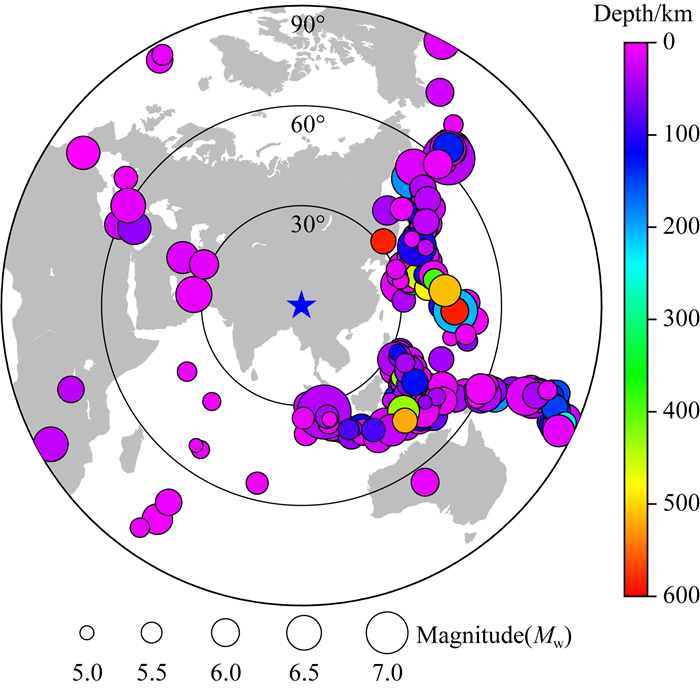
|
图 3 地震事件震中分布图 Fig. 3 The distribution map of the epicenters |
本次研究应用Teanby等(2004)提出的横波分裂方法进行Pms波分裂测量,该方法在Silver和Chan(1991)的网格搜索算法基础上,使用自动网格搜索进行横波分裂测量,并对得到的各向异性参数应用聚类分析算法获取最佳参数,这一方法在国内外多个地区均有应用,获得了较为可靠的结果(Savage et al., 2010; 张广成等, 2013; 强正阳等, 2016; 谢振新等, 2017).
在方法应用中,首先对Pms波选定一个分裂窗口,然后按预设的窗口数量自动变换窗口的大小和位置进行窗口划分,每个窗口都会应用Silver和Chan(1991)的算法进行各向异性测量,并以质点运动协方差矩阵特征值为标准求取最佳分裂参数.随后利用聚类分析方法确定最佳Pms波分裂窗口:不同Pms波分裂窗口组成的多个聚类中,具有最小总体方差的聚类被选为最佳聚类,最佳聚类中使方差最小的窗口为最终的Pms波分裂窗口,其对应的Pms波分裂参数即为最佳结果.最后通过人工筛选以确保结果稳定可靠,人工筛选的综合判断标准包括:(1)校正后Pms波的切向能量达到最小(图 4a);(2)校正前快、慢波波形相似,校正后波形匹配良好.质点运动轨迹由校正前的椭圆形变为校正后的直线形(图 4b);(3)解的置信区间是稳定的、收敛的(图 4c);(4)获得的结果稳定,变化幅度很小(图 4d,4e).
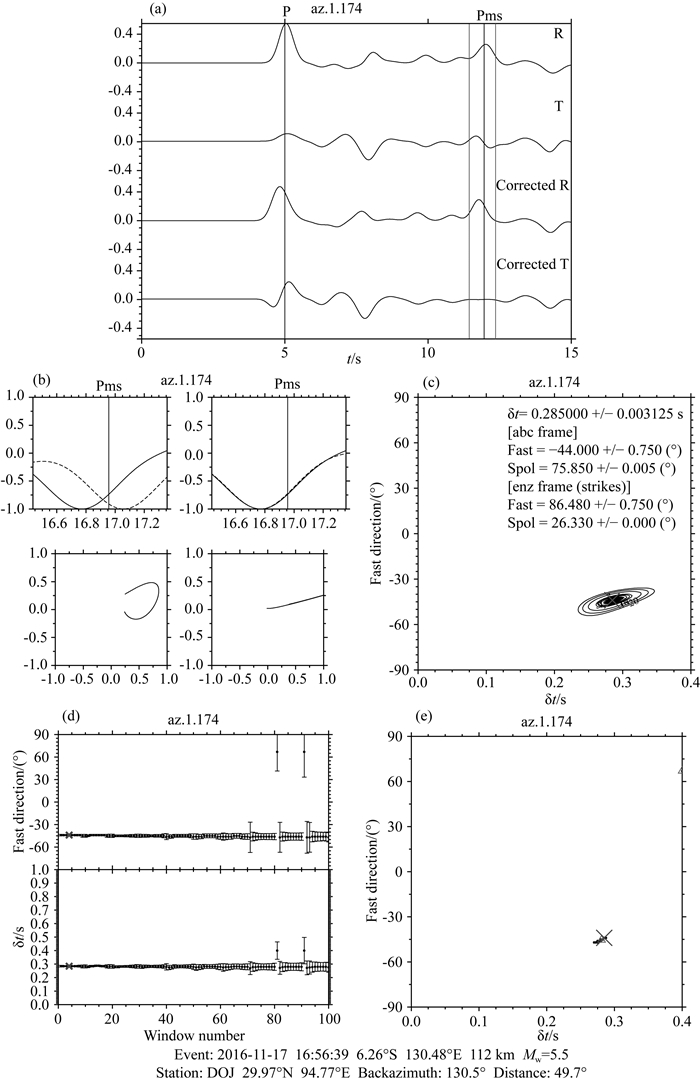
|
图 4 Pms波分裂各向异性参数测量示例 (a) 校正前后Pms波的径向分量和切向分量;(b) 快、慢波波形分析,校正前后质点运动轨迹;(c) 稳定解的收敛置信区间;(d) 所有分析窗口的各向异性参数;(e) 95%置信区间内窗口对应的各向异性参数.(c)、(d)、(e) 中最优解均由×标记. Fig. 4 An example of the Pms wave splitting measurement (a) The radial and tangential components of the Pms wave before and after correction; (b) Fast and slow wave waveform analysis, particle motion track before and after correction; (c) Convergence confidence interval of stable solution; (d) Anisotropy parameters in all analysis windows; (e) The anisotropic parameters corresponding to the windows within the 95% confidence interval. The optimal solutions in (c), (d), and (e) are all marked by crosses. |
在对横波分裂测量结果进行人工筛选后,最终在喜马拉雅东构造结及周边地区的48个台站得到了295对各向异性参数,表 1给出了各个台站横波分裂参数的平均值、标准差和有效事件数.从Pms波分裂结果来看(图 5),喜马拉雅东构造结的快波偏振方向主要为NE-SW方向,与印度板块向青藏高原下的俯冲方向一致,而东构造结周边地区的快波偏振方向呈现绕东构造结顺时针旋转的趋势.慢波延迟时间范围为0.11~0.30 s,各台站平均值为0.24 s.
|
|
表 1 各台站Pms波分裂结果 Table 1 Splitting results of each station |
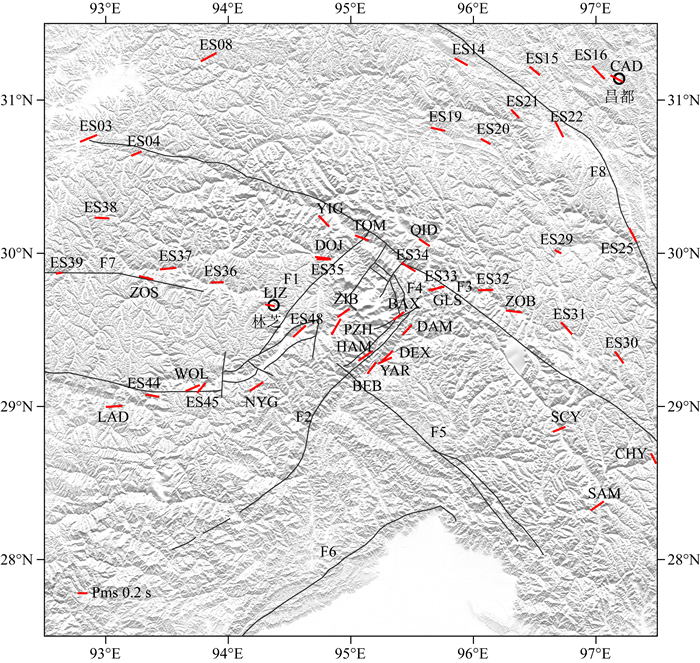
|
图 5 喜马拉雅东构造结Pms波分裂各向异性结果 Pms波分裂的快波偏振方向和慢波延迟时间用红色短棒表示. Fig. 5 The results of the Pms wave splitting in the eastern Himalayan syntaxis The results of the Pms wave splitting are plotted by red short bars. |
从Pms波分裂结果随地震事件后方位角的变化情况(图 6)可以看出,大部分台站的地震事件后方位角覆盖较好,且不同后方位角的地震事件得出的Pms波分裂结果基本一致,这说明后方位角对Pms波分裂测量影响较小,台站下方主要表现为单层各向异性介质.
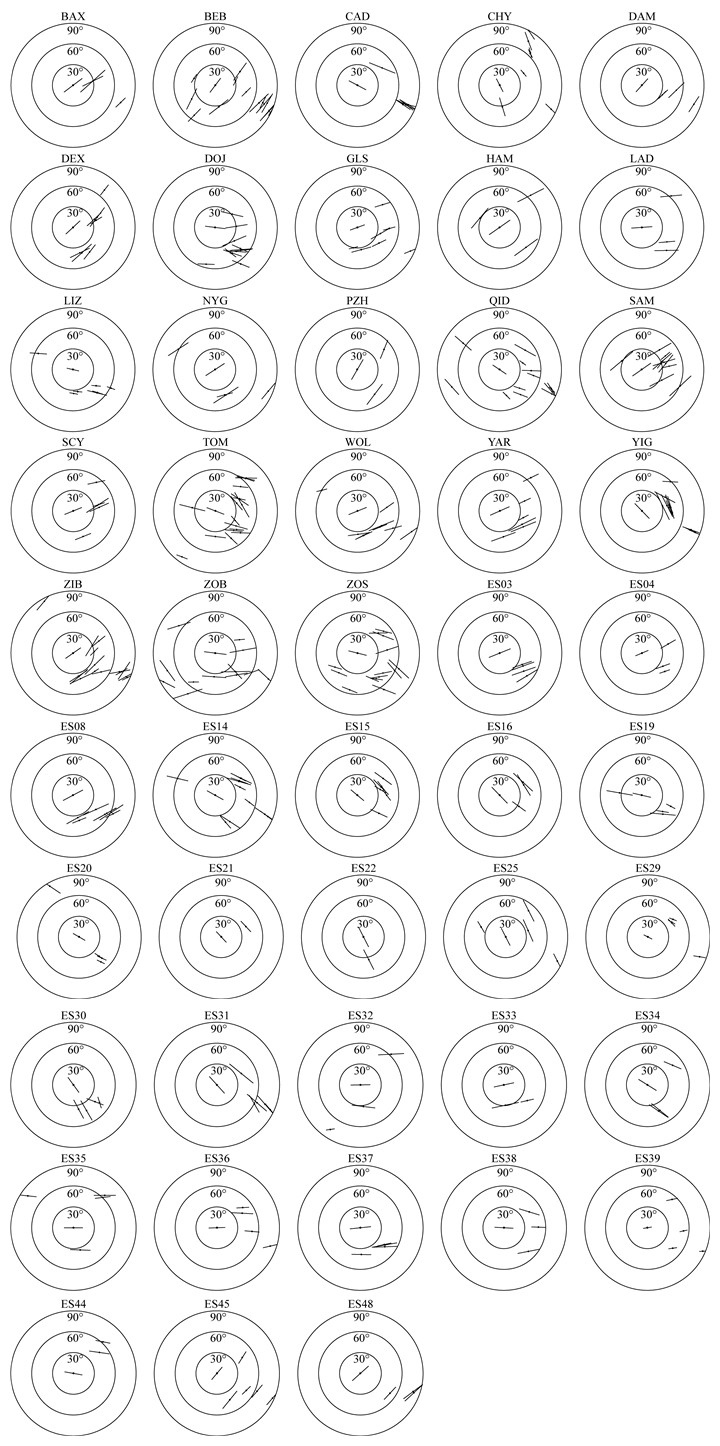
|
图 6 各台站Pms波分裂结果随地震事件后方位角分布变化情况 Fig. 6 The results of the Pms wave splitting with different back azimuths of seismic events in each station |
由于横波分裂方法获得的各向异性是横波传播路径上各向异性的综合效应(Silver and Savage, 1994),考虑到地球内部结构的复杂性,横波分裂结果中的各向异性来源往往难以确定,这里我们通过对比不同横波分裂结果,结合地表运动速度场等资料,讨论东构造结的各向异性分布、壳幔变形机制等动力学问题.
3.1 各向异性的分布在喜马拉雅东构造结已有的地壳结构研究中(程成等, 2017; Wang et al., 2019),地壳厚度由西南至东北方向逐渐增厚,上地壳埋深为20~25 km(Wang et al., 2019).将近震直达S波、Pms波和SKS波分裂的慢波延迟时间进行对比分析(图 7),当上地壳厚度为25 km时,近震S波慢波延迟时间小于0.05 s(王凯悦等, 2021),而Pms波分裂的慢波延迟时间平均值为0.24 s,这说明上地壳各向异性对Pms波分裂影响有限,即上地壳各向异性在整个地壳的各向异性中占比较小,地壳各向异性主要来自于中下地壳矿物和熔体的定向排列.由于SKS波分裂的各向异性参数代表了地壳和上地幔各向异性特征的综合效应,而喜马拉雅东构造结Pms波分裂平均为0.24 s的延迟时间相较于SKS波分裂约1.0 s的延迟时间(Chang et al., 2015)明显偏小,这表明SKS波分裂的结果主要受上地幔各向异性影响.

|
图 7 喜马拉雅东构造结各向异性综合分析图 Pms波分裂结果用红色短棒表示;SKS波分裂结果用绿色短棒表示(Sol et al., 2007; Chang et al., 2015);近震直达S波分裂结果用蓝色短棒表示(王凯悦等, 2021). Fig. 7 Comprehensive analysis diagram of anisotropy in the eastern Himalayan syntaxis The results of the Pms wave splitting are plotted by red short bars; the results of the SKS wave splitting of the predecessors are plotted by green short bars (Sol et al., 2007; Chang et al., 2015); the results of the direct S wave splitting of the predecessor are plotted by blue short bars (Wang et al., 2021). |
喜马拉雅东构造结内部快波偏振方向整体呈NE-SW方向,与南迦巴瓦变质体受制于东西两侧走滑断裂而相对喜马拉雅地体向北推移,插入拉萨地体之下的构造特征相一致(许志琴等, 2008).在印度板块向欧亚板块的俯冲作用下,东构造结及周边地区的主压应力场方向为NNE-SSW方向(许忠淮, 2001),而由GPS和断裂第四纪滑动速率数据分析得到的压应变方向同样是NNE-SSW方向,均与喜马拉雅东构造结的快波偏振方向相近.在GPS测量得到的相对于稳定欧亚大陆参考系的地表运动速度场结果(Gan et al., 2007; Wang and Shen, 2020)中,东构造结及周边地区的地表运动速度场方向绕东构造结顺时针旋转,与Pms波分裂得到的快波偏振方向变化趋势一致.
对比喜马拉雅东构造结的上地壳各向异性研究结果(郭铁龙和高原, 2020; 王凯悦等, 2021)中得到的快波偏振方向与Pms波分裂的快波偏振方向可以发现,二者在大部分台站是相近的,在3.1节的讨论中认为Pms波分裂主要反映了中下地壳各向异性,东构造结上下地壳的各向异性快波偏振方向相近说明地壳内部变形特征是一致的,上下地壳变形耦合.而部分台站上下地壳各向异性快波偏振方向的差异,如LIZ台站(郭铁龙和高原, 2020)、LAD台站(王凯悦等, 2021),可能原因是上下地壳各向异性来源不同,东构造结局部构造对上地壳各向异性有较大影响,王凯悦等(2021)的各向异性结果中快波偏振方向和慢波延迟时间较大的离散度也说明了东构造结的复杂构造和剧烈变形对上地壳各向异性的影响.
在Sol等(2007)和Chang等(2015)的SKS波分裂研究结果中,喜马拉雅东构造结快波偏振方向为NE-SW方向,周边地区快波偏振方向自西向东呈现出围绕东构造结顺时针旋转的特征.根据快波偏振方向的对比可以看出(图 7),Pms波分裂与SKS波分裂的快波偏振方向表现出较好的一致性,这表明东构造结及周边地区地壳和上地幔的变形特征是一致的,在碰撞变形造山过程中深浅变形可能是耦合的.
综合考虑喜马拉雅东构造结及周边地区已有的近震直达S波分裂、Pms波分裂、SKS波分裂结果(图 7),可以发现东构造结及周边地区岩石圈不同深度的各向异性快波偏振方向呈现出较好的一致性趋势:在东构造结内部快波偏振方向主要为NE-SW方向,在东构造结周边地区快波偏振方向呈现出绕东构造结顺时针旋转的趋势,这说明地壳与上地幔变形特征基本一致,结合地表运动速度场也呈现出绕东构造结明显的顺时针旋转特征,可以推断出喜马拉雅东构造结及周边地区岩石圈变形可能为壳幔耦合的垂直连贯变形模式.Chang等(2015)在垂直连贯变形模型假设下,通过GPS测量的地表变形数据推测的深部地幔变形快波偏振方向与SKS波分裂结果一致性较好,同样说明东构造结及周边地区岩石圈变形为壳幔耦合的垂直连贯变形模式.此外,Silver(1996)认为垂直连贯变形模式地区的快波偏振方向一般平行于地表的构造走向,如造山带、大型走滑断裂带等,由图 7可以看出,大部分台站的横波分裂快波偏振方向与断裂带等地表构造走向是基本平行的,这也说明喜马拉雅东构造结及周边地区符合垂直连贯变形模式地区的特征.
4 结论本文通过对提取接收函数得到的Pms波进行横波分裂测量,获取了喜马拉雅东构造结及周边地区48个台站的地壳各向异性参数,得到了研究区地壳各向异性特征.喜马拉雅东构造结的Pms波分裂快波偏振方向整体为NE-SW方向,与印度板块向青藏高原下的俯冲方向一致,其周边地区快波偏振方向绕东构造结有顺时针旋转的趋势.对比近震直达S波、Pms波和SKS波分裂的结果发现,研究区上地壳各向异性对地壳各向异性影响较小,地壳各向异性主要来源于中下地壳;地壳各向异性对SKS波分裂的影响有限,SKS波分裂主要反映了上地幔各向异性特征.综合上地壳、地壳和上地幔各向异性结果进行对比分析,并结合地表变形和构造特征发现东构造结及周边地区深浅变形特征具有较好的一致性,反映了喜马拉雅东构造结及周边地区岩石圈变形可能为壳幔耦合的垂直连贯变形模式.
Anderson D L. 1961. Elastic wave propagation in layered anisotropic media. Journal of Geophysical Research, 66(9): 2953-2963. DOI:10.1029/JZ066i009p02953 |
Barruol G, Mainprice D. 1993. A quantitative evaluation of the contribution of crustal rocks to the shear-wave splitting of teleseismic SKS waves. Physics of the Earth & Planetary Interiors, 78(3-4): 281-300. |
Chang L J, Wang C Y, Ding Z F, et al. 2008. Seismic anisotropy of upper mantle in the northeastern margin of the Tibetan Plateau. Chinese Journal of Geophysics (in Chinese), 51(2): 431-438. |
Chang L J, Ding Z F, Wang C Y. 2010. Variations of shear wave splitting in the 2010 Yushu MS7.1 earthquake region. Chinese Journal of Geophysics (in Chinese), 53(11): 2613-2619. DOI:10.3969/j.issn.0001-5733.2010.11.009 |
Chang L J, Flesch L M, Wang C Y, et al. 2015. Vertical coherence of deformation in lithosphere in the eastern Himalayan syntaxis using GPS, Quaternary fault slip rates, and shear wave splitting data. Geophysical Research Letters, 42(14): 5813-5819. DOI:10.1002/2015GL064568 |
Chang L J, Ding Z F, Wang C Y, et al. 2017. Vertical coherence of deformation in lithosphere in the NE margin of the Tibetan plateau using GPS and shear-wave splitting data. Tectonophysics, 699: 93-101. DOI:10.1016/j.tecto.2017.01.025 |
Chang L J, Ding Z F, Wang C Y. 2018. Upper crustal anisotropy observed around the Longmenshan fault in the 2013 MS7.0 Lushan earthquake region. Earthquake Science, 31(4): 187-198. DOI:10.29382/eqs-2018-0187-2 |
Chen Y, Zhang Z J, Sun C Q, et al. 2013. Crustal anisotropy from Moho converted Ps wave splitting analysis and geodynamic implications beneath the eastern margin of Tibet and surrounding regions. Gondwana Research, 24(3-4): 946-957. DOI:10.1016/j.gr.2012.04.003 |
Cheng C, Bai L, Ding L, et al. 2017. Crustal structure of Eastern Himalayan Syntaxis revealed by receiver function method. Chinese Journal of Geophysics (in Chinese), 60(8): 2969-2979. DOI:10.6038/cjg20170806 |
Christensen N I. 1984. The magnitude, symmetry and origin of upper mantle anisotropy based on fabric analyses of ultramafic tectonites. Geophysical Journal International, 76(1): 89-111. DOI:10.1111/j.1365-246X.1984.tb05025.x |
Crampin S. 1981. A review of wave motion in anisotropic and cracked elastic-media. Wave Motion, 3(4): 343-391. DOI:10.1016/0165-2125(81)90026-3 |
Crampin S. 1984. Effective anisotropic elastic constants for wave propagation through cracked solids. Geophysical Journal International, 76(1): 135-145. DOI:10.1111/j.1365-246X.1984.tb05029.x |
Crampin S, Atkinson B K. 1985. Microcracks in the Earth's crust. First Break, 3(3): 16-20. |
Crampin S. 1994. The fracture criticality of crustal rocks. Geophysical Journal International, 118(2): 428-438. DOI:10.1111/j.1365-246X.1994.tb03974.x |
Crampin S, Peacock S. 2008. A review of the current understanding of seismic shear-wave splitting in the Earth's crust and common fallacies in interpretation. Wave Motion, 45(6): 675-722. DOI:10.1016/j.wavemoti.2008.01.003 |
Ding Z F, Zeng R S. 1996. Observation and study of shear wave anisotropy in Tibetan Plateau. Acta Geophysica Sinica (in Chinese), 39(2): 211-220. |
Ding Z F, Wu Y, Wang H, et al. 2008. Variations of shear wave splitting in the 2008 Wenchuan earthquake region. Science in China Series D: Earth Sciences, 51(12): 1712-1716. DOI:10.1007/s11430-008-0141-1 |
Gan W J, Zhang P Z, Shen Z K, et al. 2007. Present-day crustal motion within the Tibetan Plateau inferred from GPS measurements. Journal of Geophysical Research: Solid Earth, 112(B8): B08416. DOI:10.1029/2005JB004120 |
Gao Y, Shi Y T, Chen A G. 2018. Crustal seismic anisotropy and compressive stress in the eastern margin of the Tibetan Plateau and the influence of the MS8.0 Wenchuan earthquake. Chinese Science Bulletin (in Chinese), 63(19): 1934-1948. DOI:10.1360/N972018-00317 |
Gao Y, Chen A G, Shi Y T, et al. 2019. Preliminary analysis of crustal shear-wave splitting in the Sanjiang lateral collision zone of the southeast margin of the Tibetan Plateau and its tectonic implications. Geophysical Prospecting, 67(9): 2432-2449. DOI:10.1111/1365-2478.12870 |
Guo T L, Gao Y. 2020. Seismic anisotropy in the upper crust within Tibetan Plateau revealed by shear-wave splitting. Chinese Journal of Geophysics (in Chinese), 63(3): 1085-1103. DOI:10.6038/cjg2020N0156 |
Jiang M, Lü Q T, Shi D N, et al. 1996. The study on the structure of crust and upper mantle with natural earthquakes in central Tibetan Plateau. Acta Geophysica Sinica (in Chinese), 39(4): 438-439. |
Li G H, Bai L, Ding L, et al. 2020. Source parameters of the 2019 MS6.3 Medog earthquake and its tectonic implications. Chinese Journal of Geophysics (in Chinese), 63(3): 1214-1223. DOI:10.6038/cjg2020N0231 |
Ligorría J P, Ammon C J. 1999. Iterative deconvolution and receiver-function estimation. Bulletin of the Seismological Society of America, 89(5): 1395-1400. DOI:10.1785/BSSA0890051395 |
Lü Q T, Ma K Y, Jiang M, et al. 1996. Seismic anisotropy beneath Southern Tibet. Acta Seismologica Sinica (in Chinese), 18(2): 215-223. |
Nicolas A, Boudier F, Boullier A M. 1973. Mechanisms of flow in naturally and experimentally deformed peridotites. American Journal of Science, 273(10): 853-876. DOI:10.2475/ajs.273.10.853 |
Peng M, Tan H D, Jiang M, et al. 2012. Joint inversion of receiver functions and magnetotelluric data: Application to crustal and mantle structure beneath central Namche Barwa, eastern Himalayan syntaxis. Chinese Journal of Geophysics (in Chinese), 55(7): 2281-2291. DOI:10.6038/j.issn.0001-5733.2012.07.014 |
Qiang Z Y, Wu Q J, Li Y H, et al. 2016. Crustal anisotropy beneath central-south Mongolia and its dynamic implications. Chinese Journal of Geophysics (in Chinese), 59(5): 1616-1628. DOI:10.6038/cjg20160507 |
Savage M K. 1999. Seismic anisotropy and mantle deformation: What have we learned from shear wave splitting?. Reviews of Geophysics, 37(1): 65-106. DOI:10.1029/98RG02075 |
Savage M K, Wessel A, Teanby N A, et al. 2010. Automatic measurement of shear wave splitting and applications to time varying anisotropy at Mount Ruapehu Volcano, New Zealand. Journal of Geophysical Research: Solid Earth, 115(B12): B12321. DOI:10.1029/2010JB007722 |
Shi D N, Dong Y J, Jiang M, et al. 1996. Shear wave anisotropy of the upper mantle beneath the Tingri of Tibet to Golmud of Qinghai. Acta Geologica Sinica (in Chinese), 70(4): 291-297. |
Silver P G, Chan W W. 1991. Shear wave splitting and subcontinental mantle deformation. Journal of Geophysical Research: Solid Earth, 96(B10): 16429-16454. DOI:10.1029/91JB00899 |
Silver P G, Savage M K. 1994. The interpretation of shear-wave splitting parameters in the presence of two anisotropic layers. Geophysical Journal International, 119(3): 949-963. DOI:10.1111/j.1365-246X.1994.tb04027.x |
Silver P G. 1996. Seismic anisotropy beneath the continents: Probing the depths of geology. Annual Review of Earth and Planetary Sciences, 24(1): 385-432. DOI:10.1146/annurev.earth.24.1.385 |
Sol S, Meltzer A, Burgmann R, et al. 2007. Geodynamics of the southeastern Tibetan Plateau from seismic anisotropy and geodesy. Geology, 35(6): 563-566. DOI:10.1130/G23408A.1 |
Tapponnier P, Peltzer G, Le Dain A Y, et al. 1982. Propagating extrusion tectonics in Asia: New insights from simple experiments with plasticine. Geology, 10(12): 611-616. DOI:10.1130/0091-7613(1982)10<611:PETIAN>2.0.CO;2 |
Tapponnier P, Xu Z Q, Roger F, et al. 2001. Oblique stepwise rise and growth of the Tibet plateau. Science, 294(5547): 1671-1677. DOI:10.1126/science.105978 |
Teanby N A, Kendall J M, Van Der Baan M, et al. 2004. Automation of shear-wave splitting measurements using cluster analysis. Bulletin of the Seismological Society of America, 94(2): 453-463. DOI:10.1785/0120030123 |
Teng J W, Yang D H, Tian X B, et al. 2019. Geophysical investigation progresses of the Qinghai Tibetan plateau in the past 70 years. Scientia Sinica Terrae (in Chinese), 49(10): 1546-1564. DOI:10.1360/SSTe-2019-0132 |
Wang C Y, Chang L J, Lü Z Y, et al. 2007. Seismic anisotropy of upper mantle in eastern Tibetan Plateau and related crust-mantle coupling pattern. Science in China Series D: Earth Sciences, 50(8): 1150-1160. DOI:10.1007/s11430-007-0053-5 |
Wang C Y, Mooney W D, Zhu L, et al. 2019. Deep structure of the eastern Himalayan collision zone: Evidence for underthrusting and delamination in the postcollisional stage. Tectonics, 38(10): 3614-3628. DOI:10.1029/2019TC005483 |
Wang K Y, Chang L J, Ding Z F. 2021. Upper crustal anisotropy in the eastern Himalayan syntaxis. Acta Seismologica Sinica (in Chinese), 43(2): 168-179. |
Wang M, Shen Z K. 2020. Present-day crustal deformation of continental China derived From GPS and its tectonic implications. Journal of Geophysical Research: Solid Earth, 125(2): e2019JB018774. DOI:10.1029/2019JB018774 |
Weiss T, Siegesmund S, Rabbel W, et al. 1999. Seismic velocities and anisotropy of the lower continental crust: A review. //Seismic Exploration of the Deep Continental Crust. Basel: Birkhäuser, 97-122.
|
Wu P, Gao Y, Chen A G, et al. 2020. Preliminary study on the anisotropy of the upper crust in the Sanjiang area, southeastern margin of the Tibetan Plateau. Chinese Journal of Geophysics (in Chinese), 63(3): 1104-1116. DOI:10.6038/cjg2020N0232 |
Xie Z X, Wu Q J, Zhang R Q. 2017. Crustal anisotropy beneath northeastern margin of the Tibetan Plateau and its dynamic implications. Chinese Journal of Geophysics (in Chinese), 60(6): 2315-2325. DOI:10.6038/cjg20170623 |
Xu Z H. 2001. A present-day tectonic stress map for eastern Asia region. Acta Seismologica Sinica (in Chinese), 23(5): 492-501. |
Xu Z Q, Cai Z H, Zhang Z M, et al. 2008. Tectonics and fabric kinematics of the Namche Barwa terrane, Eastern Himalayan Syntaxis. Acta Petrologica Sinica (in Chinese), 24(7): 1463-1476. |
Yin A, Harrison T M. 2000. Geologic evolution of the Himalayan-Tibetan orogen. Annual Review of Earth and Planetary Sciences, 28(1): 211-280. DOI:10.1146/annurev.earth.28.1.211 |
Zhang G C, Wu Q J, Li Y J, et al. 2013. An investigation on crustal anisotropy of Northeast China using Moho Ps converted phase. Acta Seismologica Sinica (in Chinese), 35(4): 485-497. |
Zheng T, Gao S S, Ding Z F, et al. 2021. Crustal azimuthal anisotropy and deformation beneath the northeastern Tibetan Plateau and adjacent areas: Insights from receiver function analysis. Tectonophysics, 816: 229014. DOI:10.1016/j.tecto.2021.229014 |
常利军, 王椿镛, 丁志峰, 等. 2008. 青藏高原东北缘上地幔各向异性研究. 地球物理学报, 51(2): 431-438. DOI:10.3321/j.issn:0001-5733.2008.02.015 |
常利军, 丁志峰, 王椿镛. 2010. 2010年玉树7.1级地震震源区横波分裂的变化特征. 地球物理学报, 53(11): 2613-2619. DOI:10.3969/j.issn.0001-5733.2010.11.009 |
程成, 白玲, 丁林, 等. 2017. 利用接收函数方法研究喜马拉雅东构造结地区地壳结构. 地球物理学报, 60(8): 2969-2979. DOI:10.6038/cjg20170806 |
丁志峰, 曾融生. 1996. 青藏高原横波分裂的观测研究. 地球物理学报, 39(2): 211-220. DOI:10.3321/j.issn:0001-5733.1996.02.008 |
丁志峰, 武岩, 王辉, 等. 2008. 2008年汶川地震震源区横波分裂的变化特征. 中国科学(D辑: 地球科学), 38(12): 1600-1604. DOI:10.3321/j.issn:1006-9267.2008.12.013 |
高原, 石玉涛, 陈安国. 2018. 青藏高原东缘地震各向异性、应力及汶川地震影响. 科学通报, 63(19): 1934-1948. |
郭铁龙, 高原. 2020. 剪切波分裂揭示的青藏高原上地壳地震各向异性基本特征. 地球物理学报, 63(3): 1085-1103. DOI:10.6038/cjg2020N0156 |
姜枚, 吕庆田, 史大年, 等. 1996. 用天然地震探测青藏高原中部地壳、上地幔结构. 地球物理学报, 39(4): 438-439. |
李国辉, 白玲, 丁林, 等. 2020. 2019年西藏墨脱MS6.3地震震源参数及其构造意义. 地球物理学报, 63(3): 1214-1223. DOI:10.6038/cjg2020N0231 |
吕庆田, 马开义, 姜枚, 等. 1996. 青藏高原南部下的横波各向异性. 地震学报, 18(2): 215-223. |
彭淼, 谭捍东, 姜枚, 等. 2012. 利用接收函数和大地电磁数据联合反演南迦巴瓦构造结中部地区壳幔结构. 地球物理学报, 55(7): 2281-2291. DOI:10.6038/j.issn.0001-5733.2012.07.014 |
强正阳, 吴庆举, 李永华, 等. 2016. 蒙古中南部地区地壳各向异性及其动力学意义. 地球物理学报, 59(5): 1616-1628. DOI:10.6038/cjg20160507 |
史大年, 董英君, 姜枚, 等. 1996. 西藏定日-青海格尔木上地幔各向异性研究. 地质学报, 70(4): 291-297. DOI:10.3321/j.issn:0001-5717.1996.04.001 |
滕吉文, 杨顶辉, 田小波, 等. 2019. 青藏高原深部地球物理探测70年. 中国科学: 地球科学, 49(10): 1546-1564. |
王椿镛, 常利军, 吕智勇, 等. 2007. 青藏高原东部上地幔各向异性及相关的壳幔耦合型式. 中国科学(D辑: 地球科学), 37(4): 495-503. |
王凯悦, 常利军, 丁志峰. 2021. 喜马拉雅东构造结上地壳各向异性特征. 地震学报, 43(2): 168-179. |
吴鹏, 高原, 陈安国, 等. 2020. 青藏高原东南缘三江地区上地壳各向异性初步研究. 地球物理学报, 63(3): 1104-1116. DOI:10.6038/cjg2020N0232 |
谢振新, 吴庆举, 张瑞青. 2017. 青藏高原东北缘地壳各向异性及其动力学意义. 地球物理学报, 60(6): 2315-2325. DOI:10.6038/cjg20170623 |
许忠淮. 2001. 东亚地区现今构造应力图的编制. 地震学报, 23(5): 492-501. DOI:10.3321/j.issn:0253-3782.2001.05.005 |
许志琴, 蔡志慧, 张泽明, 等. 2008. 喜马拉雅东构造结——南迦巴瓦构造及组构运动学. 岩石学报, 24(7): 1463-1476. |
张广成, 吴庆举, 李永华, 等. 2013. 利用莫霍面Ps震相研究中国东北地区地壳各向异性. 地震学报, 35(4): 485-497. DOI:10.3969/j.issn.0253-3782.2013.04.004 |
 2021, Vol. 64
2021, Vol. 64

